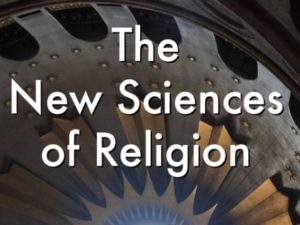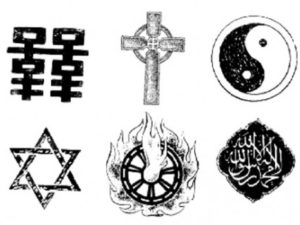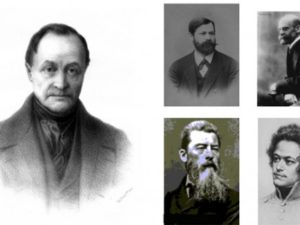NSoR 4: The Evolution of Religion

An excerpt from Chapter 4 of The New Sciences of Religion: Exploring Spirituality from the Outside In and Bottom Up (Palgrave Macmillan, 2010) Pages 89 – 91.
Another evolutionary approach to explaining religion revives group-selection theory or, more properly, multilevel-selection theory. Selection works not just at the level of individual genes but also on networks of genes, individual phenotypes, groups of individuals, and even at the level of groups of species in ecosystems. The relevant level of analysis will be determined by the specific context.
Humans, like social insects, survive and reproduce in groups, so group selection makes sense. In this view, religions contribute to group survival and reproduction in diverse environments and in competition with other human groups. In particular, religions provide a way to promote group solidarity and cooperation, while minimizing the problem of freeloaders and defections.
One sees this in the frequent use of the body metaphor to describe the community. Plato invokes the metaphor of the body politic in The Republic. The Christian Church is referred to as the “Body of Christ.” Many Buddhist monasteries in China and Japan are built in the shape of a human body. The Ummah can be thought of as the body of Islam.
David Sloan Wilson, trained in animal ethology, is leading this effort to revive group-selection theory, especially in its application to understanding religion. His book Darwin’s Cathedral uses examples such as the Hutterites, John Calvin’s (1509-1564) Geneva, the survival of Judaism in the Diaspora, and the Hindu Water Temple system in Bali.34 Wilson argues that religions are not true, not in a factual sense, but they work in a practical sense. He is in awe of the practical power of religion as a group-level adaptation.
One of the insights derived from Wilson’s approach is the dynamics of strict sects. The higher the price of admission to a religious group — in terms of the demands of observance, including strict rules and nonconformist dress and practices — the higher the benefits of membership and the greater the cost of defection or freeloading. Liberal religions, in this competitive market, tend to lose members and have more freeloaders. This is an insight we also discovered in our discussion about the economics of religion in the last chapter.
The dark side of the unifying spirit of religion is that it is often harnessed in violent conflict with outsiders. This troubles Wilson, as it should trouble all of us in contemplating the growing culture wars within and between our great civilizations. Objectively though, Wilson does not have high expectations of religions. He writes that “the failure of religion to achieve universal brotherhood is like the failure of birds to break the sound barrier.”35
This distinction between factual realism and practical realism creates an interesting set of problems for Wilson and for us. “An atheist historian,” writes Wilson, “who understood the real life of Jesus but whose own life was a mess as a result of his beliefs would be factually attached to and practically detached from reality.” He continues:
Much religious belief does not represent a form of mental weakness but rather the healthy functioning of the biologically and culturally well-adapted mind. Rationality is not the gold standard against which all other forms of thought are to be judged. Adaptation is the gold standard against which rationality must be judged, along with all other forms of thought. (italics added)36
This is a remarkable statement on two counts. First, it implies that the religious function, if not any particular religion, is necessary for any community or individual. A religion can be abolished, but it had better be replaced by another religion or the group will fail. Second, making rationality subservient to adaptation raises profound philosophical questions about the truth claims of both science and religion. Science might be factually true but practically false. Reflect for a moment on weapons of mass destruction, growing environmental problems, and alienated publics. Wilson suggests that ?science might profit by becoming more religious along certain dimensions, as long as it remains nonreligious with respect to its stated goal of increasing factual knowledge.? iv Science as a community and institution also needs a unifying spirit. Yoking science and religion in a mutually constructive manner may hold the greatest promise for advancing both truth and goodness in the twenty-first century, a topic we will explore in part 2.
4. Lamarckian Cultural Evolution
I want to present a fourth evolutionary option to help us explain and understand religion. While the scenarios above are often presented as mutually exclusive, there is no reason that all these theories cannot be partially true, applicable in different circumstances, nuanced in different ways.
Our minds are surely shaped by evolution. We think and act through many innate and learned mental modules. Religion, like any human thought, including science itself, necessarily harnesses these inference systems. Much of religion may be spandrel-like elaborations that serve no profound truth about humans or the universe. Religious practices may in large part be more like the differences between musical genres and human languages around the world. In other words, we can argue about correct Chinese grammar and our favorite jazz bands, but it makes little sense to argue about whether Chinese is better or worse than French or whether jazz is better or worse than classical Indian ragas.
Religions can also be seen as group adaptations, as well as individual-level adaptations that help promote successful communities and successful lives. Our pressing challenge in this context is to figure out how to make religions more functional and more adaptive in the context of the modern world. The warring minds of the hunter-gatherer may not thrive or survive twenty-first-century forms of chauvinistic tribalism, the emotional manipulations of modern mass media, and the growing availability of weapons of mass destruction.
The notion of memes also opens up other options, even if we reject the metaphor as a fiction. To the extent that we do have a dual-inheritance system — genetic and mental — then something altogether new is going on in evolution. Once evolution gave rise to our symbolic species with language, thought, tools, and culture, the Darwinian paradigm begins to take back seat to what we should now call the Lamarckian paradigm.38 Human have the capacity to pass on new innovations more or less directly to the next generation. Indeed, that is the whole purpose of education: to pass on and improve upon the discoveries, inventions, and wisdom of the ages. We do not need to reinvent the wheel or the microprocessor. We do not need to rewrite the Bible or the Bhagavad Gita. Once human symbolic evolution takes off, it proceeds rapidly; indeed, it is growing exponentially in the modern era. Humans engage in large-scale environmental engineering and are reshaping the earth. We are about to embark upon large-scale genetic engineering of other species and ourselves. Selection will continue to operate in the future, but the source of variation will be the intentional tinkering of humans, along with many unintended consequences. The future evolution of the planet will be increasingly dominated by human desires and values. Willy-nilly, we have stumbled into designer evolution, not that we completely understand what we are doing or can predict what the consequences will be. From the perspective of evolutionary history, it is perhaps not an exaggeration to say that nothing as significant as humans has occurred on the planet since the advent of photosynthesis some 2 billion years ago.
The point is that we humans increasingly transcend our biological origins. We are not slaves to our genes, nor need our morality be a slave to mere survival and reproduction. Humans are a transcendent species. On one level, we are simply another mammal; on another, we are more like a whole new phylum in the epic of evolution.







